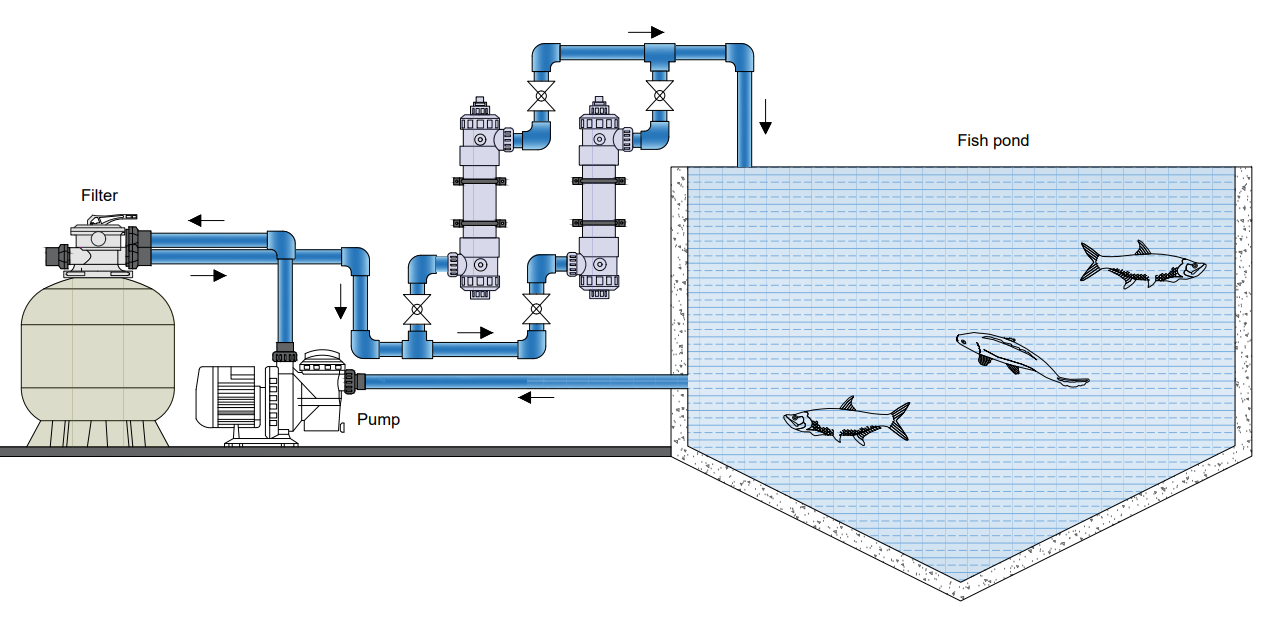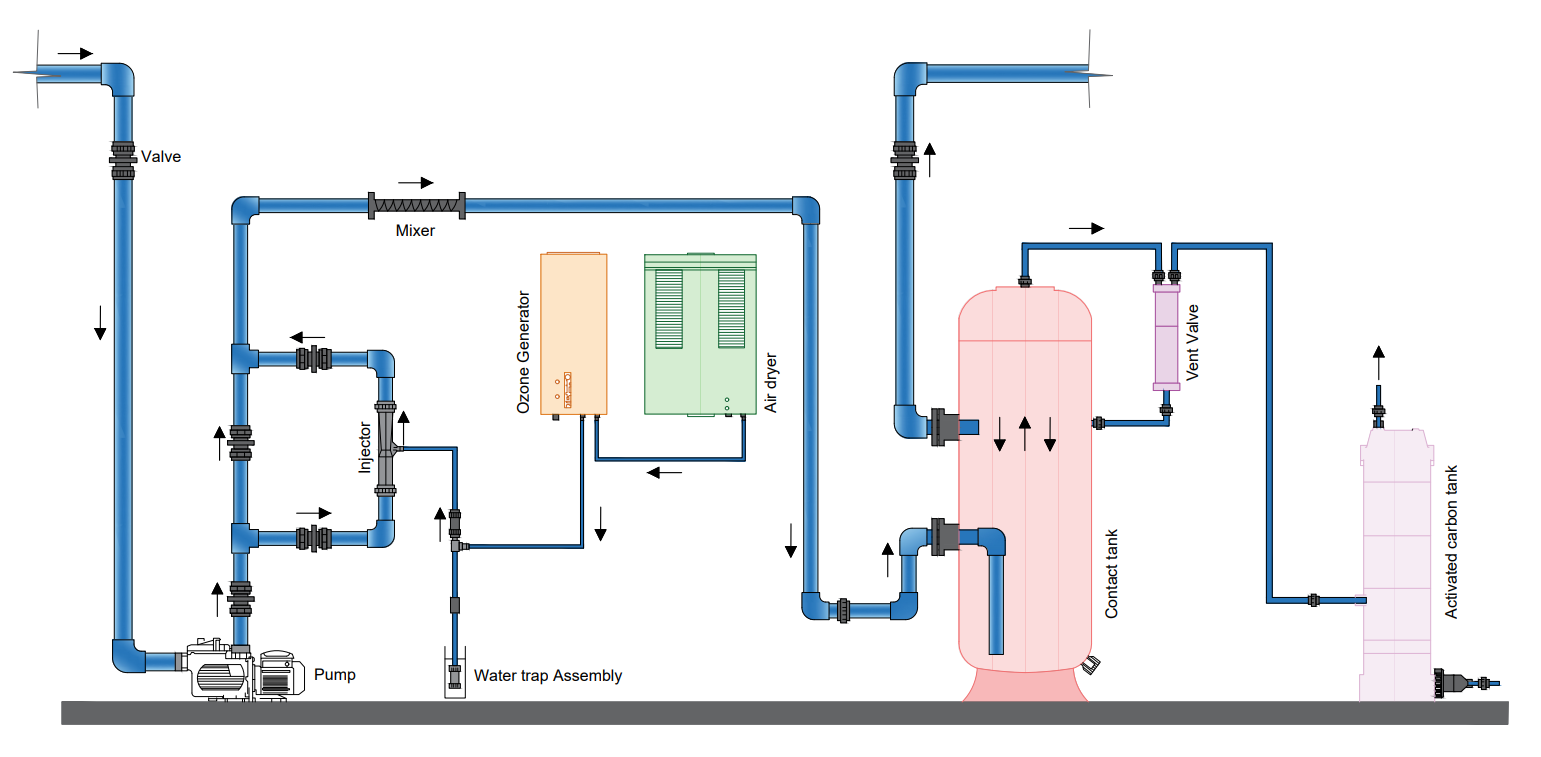Factors affecting the choice of disinfection techniques
Selecting a particular technique of disinfection for a particular aquaculture establishment depends upon various factors such as the effectiveness of the process, the risks involved, and the mode of operation required for the control of disease or eradication. Even though we could use different techniques to achieve disinfection depending upon various factors listed above, the general objectives listed below apply to all methodologies.
1) The disinfection process should include the following phases as illustrated in fig.1.

Fig.1 - The general disinfection methodology in aquaculture
2) Disinfectants should be applied following the standard environmental health legislation.
3) The injected dosage and its efficiency must be properly checked at regular intervals.
4) There must be a record for the disinfection techniques applied in aquaculture establishments, for evaluation and improvement of the processes performed.
The disinfection procedure for an aquaculture establishment mainly consists of removal of aquatic animals from the facilities before disinfection by humanely culling them and disposing of the water in the establishment indirectly for avoiding the spread of pathogens to the surrounding ecosystem.
There are various methodologies adopted for the disinfection of fish farms and are chosen based on the permeability of the material of the establishment, while it is easier and takes a lesser amount of time to disinfect the impermeable materials. The legal legislation concerned with the dosing level of a particular chemical agent may vary between the regions and is another factor that must be taken into consideration. The disinfection process must be pre-processed with a compatible detergent cleansing as solutions of iodophor cannot be used with alkaline surfaces like concrete for cleaning due to their acidic nature. In the case of aquaculture establishments connected to the land such as ponds, raceways, etc, they should be properly disinfected before restocking.
Listing of various disinfection techniques
1. Oxidizing agents
Common oxidizing agents which find application in aquaculture include compounds of chlorine, chloramine – T, iodophor, etc, which are very effective in disinfecting a large group of microorganisms. The presence of organic matter inhibits the cleansing effect of the oxidizing compounds by reducing them, so the residual levels of such compounds should be monitored continuously to ensure that the minimum dosing levels are kept for the required period. Oxidizing agents are harmful to aquatic animals and after disinfection, they have to be inactivated before using the aquaculture establishment. The procedure of disinfection varies with the different oxidizing agents; the pH for iodophor solutions should be maintained between 6 and 8, and sodium carbonate solutions should be added at the rate of 100 ppm before disinfection, with an effective time not less than 10 minutes. For disinfecting eggs belonging to salmonoid species, the eggs must be rinsed with 0.9% saline solution for 30 to 60 seconds before and after disinfection, apart from maintaining the above requirements. The solution should only be used once in a while.
2. pH conditioners
Altering the pH of media is another disinfection technique used in pipes, biofilters, etc where other effective disinfection techniques are not possible. This technique involves the use of alkaline compounds like sodium hypochlorite or acids like Peracetic acid (PAA). The concentration of pH conditioners can be easily determined, and it cannot be inactivated by the presence of reducing action organic matter. While disinfecting pipelines, sodium hypochlorite solutions should be applied at 50 ppm with an exposure time of at least 30 minutes, then flushed with freshwater followed by neutralizing chlorine using activated charcoal before discarding it to the surroundings. Acidic compounds like PAA with a concentration of around 2 ppm and an effective exposure time of 3 hours were found to be effective in disinfecting biofilters, recirculating establishments, etc.
3. Reducing agents (Aldehydes)
Aldehyde fluids like liquid glutaraldehyde or gaseous formaldehyde aid in disinfecting aquaculture establishments that are sensitive to heat by breaking the protein bonding in microbes [denaturation]. They have good disinfection efficiency against most of the microbes but need long exposure times. The aldehyde compounds can disinfect effectively even in the presence of organic matter. Glutaraldehyde solution of 400 to 600 ppm with a contact time of fewer than 10 minutes can be effectively used for disinfecting eggs of aquatic species like plaice, cod, etc which cannot be performed using oxidizers.
4. Quaternary ammonium compounds (QAC)
QACs like benzalkonium chloride finds applications in hatcheries and farms for disinfecting larvae, tanks, ponds, and other equipment. The effectiveness of QAC varies; they are effective against gram-positive bacteria and some fungi, but not so effective against viruses and spores. The QACs are generally non-corrosive and have better wetting properties that enhance contact with surfaces. QACs don’t pose any serious threat to the environment but are toxic to aquatic animals, so they should be removed from surfaces after disinfection. QACs should only be used at concentrations less than 0.3 ppm for disinfecting saltwater species like prawns from pathogens like Lactococcus garvieae.
5. Ultraviolet (UV) irradiation
UV irradiation can be thought of as a practical and non-chemical option for disinfecting the recirculating media in aquaculture establishments using powerful UV radiation emitted at a wavelength of 250 nm. UV radiations are powerful disinfectants that could inactivate the DNA of microbes and extinguish their multiplication capability. UV filters should be preceded by a filtration process since the suspended solids reduce transmission and the effectiveness of filters. The process is illustrated in fig. 2. The water is pumped into the unit through the reactor and the air drawn into the unit through the venturi system flows into the quartz glass and then into the UV lamp. The air entering the lamp is then charged with ozone molecules, then passes through a ball valve to be mixed with the circulating water in the unit.

Fig.2 - UV lamp disinfection technique in aquaculture.
6. Ozone Filtration System
Ozone filtration is a relatively advanced non-chemical technique used for controlling the microbial concentration in aquaculture establishments involving fresh as well as seawater species. Ozone can be used very effectively for controlling the ill-effects of nodaviruses when applied at 1 ppm for an exposure time of just 30 seconds in freshwater. For seawater establishments, a lower ozone concentration of approximately less than 1ppm with an exposure time of 2 to 3 minutes is significantly effective for disinfecting most of the microbes. In the case of seawater establishments involving mollusk species, the residual ozone is fatal due to the formation of oxides and should be removed before from the media before circulating it to the hatcheries by passing it through charcoal filters. In most cases, UV filtration is followed post ozonization for removing residual ozone in seawater. The entire setup also provides effective sterilization as well as an effective backup disinfection process.
Figure 3, illustrates the process flow for the ozone disinfection system, where the unit consists of a corona discharge ozone generator and an automatic air dryer unit amalgamated to provide a flow of 4 – 8 g/h of ozone. Ozone gas is generated when the air is passed over a ceramic dielectric ozone generating module containing an SS electrode and the module is powered by using a high-frequency supply. Ozone generated is injected into a water-driven venturi which ensures maximum safety against gas leakage. The air dryer unit consists of twin desiccant dryer columns that are used for improving the production rate in the generators.

Fig.3 - Ozone disinfection technique in aquaculture.
7. Combined disinfection techniques
Combined techniques involve combining more than one disinfection method in aquaculture for improving the disinfection efficacy. One such technique is combining direct sunlight and desiccation (complete drying of aquaculture establishments by eliminating moisture). The technique provides three potential disinfection actions; UV irradiation, heating, and desiccation at less or no operational cost. As indicated above, ozone and UV irradiation are often combined in series for providing backing up as well as effective different modes of disinfection.

No comments yet. Start a new discussion.